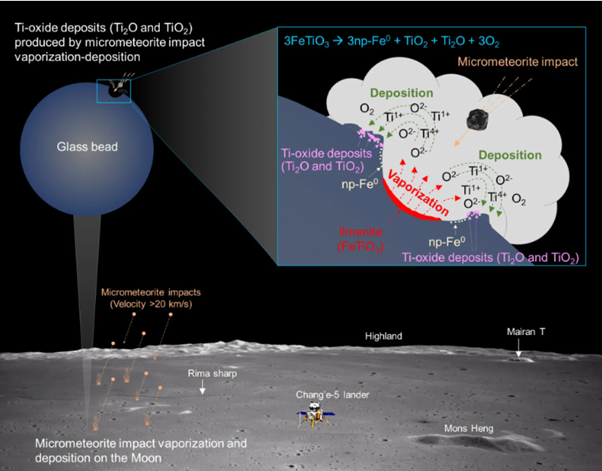Two new minerals made from titanium and oxygen have been found in lunar material brought back by the Chang’e-5 Moon mission. These are the seventh and eighth minerals to be found on the Moon and have never been seen naturally on Earth, or anywhere else.
Recent research has revealed the importance of titanium to the geology and history of the Moon. As on Earth, this titanium often comes bonded with oxygen to form titanium dioxide (TiO2). Yet the new discovery reveals these two elements can also bond in the reverse ratio, but apparently only on the Moon.
The shock produced by meteorite impacts leaves a lot of glass on the lunar surface, and the team studied a glass bead brought back by Chang’e-5. Using a transmission electron microscope, they found the same elements structured in three different ways. One of these, rutile, is the most common natural form of titanium dioxide on Earth, heavily used in optical equipment for its ability to bend light.
Titanium dioxide is found in other crystal structures on Earth. But instead of these, the team found Ti2O crystals. Referred to by the authors as trigonal and triclinic Ti2O until official names are given, the two testify to the changes wrought when there is nothing to protect titanium-rich minerals from bombardment from space.
After the Apollo astronauts returned with several minerals never found on Earth, geologists have put considerable effort into attempting to work out how they were formed. Samples were exposed to hydrogen and helium ions to replicate the solar wind and bombarded with lasers. This produces new phases of iron and silicon-rich minerals, but despite the abundance of titanium on the near side of the Moon, no new forms of titanium-bearing minerals were found, either in lunar samples or the simulations.
The problem may have been neglecting micrometeorites.
As their names suggest, micrometeorites are very small. Those thought responsible for the effects the researchers studied are 1-100 μm across, or from 0.000004 inches to a hundred times smaller. Small as they are, they can pack a punch, traveling at speeds greater than 20 km/s (45,000 mph) with no atmosphere to slow them down. On impact, they can melt the rocks they strike, even if only a tiny segment, or even vaporize them. What solidifies may be quite different from the previous material.
The bead the researchers studied, itself formed by meteorite impact, has a micrometeorite crater on it with four irregularly shaped grains that combine titanium and oxygen around its rim. All contain crystal lattices. In some cases, there are two oxygen atoms for every titanium, as expected, but the others show the reverse.

How micrometeorites turn titanium dioxide to di-titanium oxide crystals
Image Credit: Zeng et al. background image, Lunar and Planetary Data Release System
The trigonal and triclinic Ti2O have the same elemental ratios, but differ in the way the atoms are put together.
The grains are so tiny as to seem insignificant, but the authors note that titanium oxides in general act as catalysts for many reactions in the presence of sunlight. Ti2O absorbs more ultraviolet and visible light than TiO2, and is therefore likely to be an even stronger photocatalyst, potentially causing significant changes in the dust around it. Indeed, while Ti2O does not exist naturally in any structure on Earth, it has been produced in labs to make photocatalytic films.
One previous lunar mineral unknown on Earth was discovered in Chang’e-5’s samples. The other five came from the Apollo and Luna missions.
The study is published in the journal Nature Astronomy.
[H/T South China Morning Post]
Source Link: Chang’e-5 Finds Two Undiscovered Lunar Minerals Formed By Space Weathering